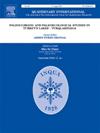New paradigms to evaluate the stratigraphy for the geological and geoarchaeological prospects of the upper and post-Siwaliks in the Soan Valley, Upper Indus Basin, Pakistan
IF 1.8
3区 地球科学
Q3 GEOGRAPHY, PHYSICAL
引用次数: 0
Abstract
The Upper Siwalik (US) of the Late Pliocene to the Middle Pleistocene and the Post-Siwalik (PS) of the Late Pleistocene to the Holocene are extensively distributed in the Upper Indus Basin. These deposits have geological and geoarchaeological significance, but they are least explored in the northwestern Himalaya, specifically in Pakistan. The current fieldwork was conducted in the Soan Valley of the Upper Indus Basin, Pakistan, through detailed stratigraphic and sedimentological investigations to address the existing research gap. Multiple methods and datasets are employed, including outcrop investigation, loss on ignition analysis, literature review, and well top data from five wells. The study identified thirteen lithofacies and six lithofacies associations, distinguished by multiple coarsening-to-fining upward cycles. These deposits indicate a transition from fluvial channel to floodplain and from alluvial to aeolian environments, showing progradation, aggradation, and retrogradation patterns across high to low accommodation system tracts (HAST and LAST). Five sequences (Sq1-Sq5) are recognized in the upper and lower Soan Valley. Sedimentary evolution was controlled by active tectonism and paleoclimates. Together with tectonic activities, LOI values indicate a transition between arid to semiarid and humid conditions, influencing the transformation of LAST and HAST, and creating a dynamic landscape for hominins in the Soan Valley. Previous studies have linked Paleolithic artefacts to these sequence stratigraphic cycles. This research lays the foundation for further geological and geoarchaeological investigations in the Soan Valley. Sequence stratigraphic and sedimentological approaches establish new paradigms, opening avenues for researchers to explore the Quaternary strata of the Himalaya and Paleolithic sites of the Soan Valley.
巴基斯坦上印度河流域Soan河谷上、后siwalik地层地质考古前景评价新范式
晚上新世至中更新世的上Siwalik (US)和晚更新世至全新世的后Siwalik (PS)广泛分布于印度河上游盆地。这些矿床具有地质和地质考古意义,但在喜马拉雅西北部,特别是在巴基斯坦,勘探最少。目前的实地工作是在巴基斯坦上印度河流域的Soan河谷进行的,通过详细的地层学和沉积学调查来解决现有的研究差距。采用了多种方法和数据集,包括露头调查、着火损失分析、文献综述和5口井的井顶数据。研究确定了13个岩相和6个岩相组合,其特征是多次粗-精向上旋回。这些沉积物显示了从河道到洪泛平原、从冲积到风成环境的过渡,表现出从高到低容纳体系域(HAST和LAST)的进积、沉积和退积模式。在苏安河谷上下游可识别出5个层序(Sq1-Sq5)。沉积演化受活动构造和古气候的控制。与构造活动一起,LOI值表明了从干旱到半干旱和湿润条件的过渡,影响了LAST和HAST的转变,并为索安河谷的人类创造了一个动态的景观。先前的研究将旧石器时代的人工制品与这些层序地层旋回联系起来。本研究为进一步开展苏安河谷地质考古调查奠定了基础。层序地层学和沉积学方法建立了新的范式,为研究人员探索喜马拉雅第四纪地层和索安河谷旧石器时代遗址开辟了途径。
本文章由计算机程序翻译,如有差异,请以英文原文为准。
求助全文
约1分钟内获得全文
求助全文
来源期刊

Quaternary International
地学-地球科学综合
CiteScore
5.60
自引率
4.50%
发文量
336
审稿时长
3 months
期刊介绍:
Quaternary International is the official journal of the International Union for Quaternary Research. The objectives are to publish a high quality scientific journal under the auspices of the premier Quaternary association that reflects the interdisciplinary nature of INQUA and records recent advances in Quaternary science that appeal to a wide audience.
This series will encompass all the full spectrum of the physical and natural sciences that are commonly employed in solving Quaternary problems. The policy is to publish peer refereed collected research papers from symposia, workshops and meetings sponsored by INQUA. In addition, other organizations may request publication of their collected works pertaining to the Quaternary.
 求助内容:
求助内容: 应助结果提醒方式:
应助结果提醒方式:


